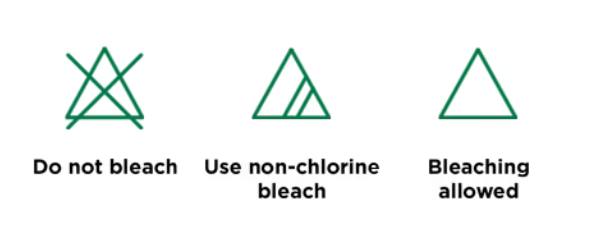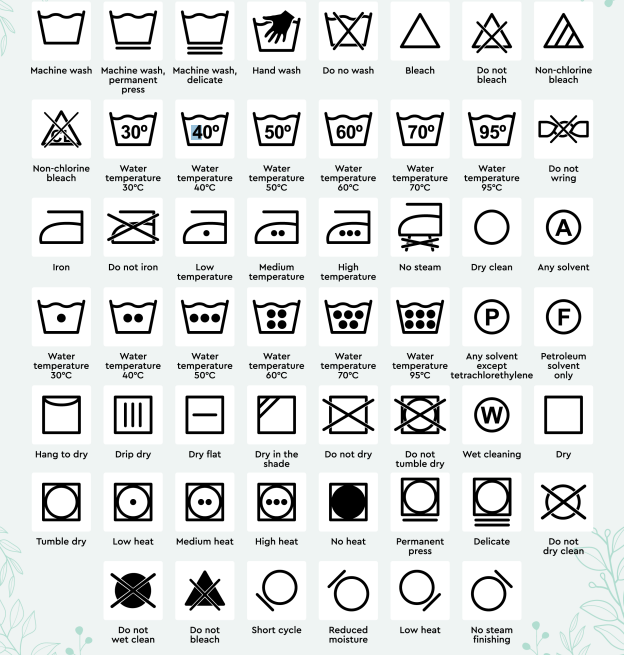Laundry symbols don’t need to feel like a puzzle. Whether you’re in a Vancouver high-rise or a family home in Halifax, understanding laundry symbols can save your clothes and your appliances from any kind of damage.
This guide explains the most common washing symbols, what they mean, and how to use them with the settings on your washer or dryer. It’s not just about cleaner laundry, but also about keeping your electricity bills down and your machines running better, too!
Washing Temperature Symbols
Getting the water temperature right matters more than most people think. Here’s what the dots mean:
- ● One Dot (30°C): Cold wash. Best for dark colours, delicates, or anything that can shrink.
- ●● Two Dots (40°C): Warm wash. A safe pick for everyday laundry.
- ●●● Three Dots (50-60°C): Hot wash. Good for towels, bedding, or clothes that need a deeper clean.
Quick Tip: Cold water protects fabric and lowers your electricity bills, especially in winter when heating water costs more.
Washing Cycle Symbols
The little lines under the washtub tell you how gentle or aggressive the wash cycle should be.
- Plain Tub: Regular cycle. Best for cotton, denim, and durable fabrics.
- Tub with One Line: Permanent press. A lower-spin option to reduce wrinkles. It is also great for synthetics.
- Tub with Two Lines: Delicate cycle. Use for lace, silk, or fine knits.
Why It Matters: Many newer washing machines have settings that match these exact symbols. Using the wrong one just might end up stretching, fading, or weakening the fabrics over time.
“Do Not Wash” Symbol
A wash tub with an X means: don’t put it in the washing machine. You’ll need to dry clean, hand wash, or spot clean the item.
Common Issue: Tossing dry-clean-only clothes in the wash can wreck zippers, textures, or linings. Always double-check.
Tumble Drying Symbols
These are the square-with-circle icons. They tell you what kind of heat is safe for the dryer.
- ● One Dot: Low heat. Use for polyester or other synthetics.
- ●● Two Dots: Medium heat. Good for most everyday items.
- ●●● Three Dots: High heat. Works for heavy fabrics like towels or bedding.
- X Over The Circle: Don’t tumble dry. Hang dry instead.
Reminder: Dryers pull a lot of power, especially in colder areas. Stick to low heat when you can to protect both fabric and your hydro bill.
Natural Drying Symbols
These give alternatives to using a dryer:
- Line Dry: Hang on a rack or clothesline.
- Dry Flat: Lay on a towel. Good for sweaters that lose shape easily.
- Drip Dry: Hang while soaking wet, no wringing.
Space-saving Tip: If you’re in a condo or suite, use foldable drying racks near vents or windows.
Ironing Symbols
Too hot = permanent damage. These symbols guide you on the safest setting:
- ● One Dot: Low heat. For silk, nylon, or delicate blends.
- ●● Two Dots: Medium heat. Works for most synthetics.
- ●●● Three Dots: High heat. Use for cotton and linen.
- X Over The Iron: Do not iron.
Tip: Always start at the lowest setting and test on the inside of the garment if unsure.
Bleach Symbols
Not all fabrics react the same way to bleach:
- Empty Triangle: Any bleach is safe.
- Triangle with Diagonal Lines: Use non-chlorine (colour-safe) bleach only.
- X Over Triangle: No bleach at all.
Canadian Note: Chlorine bleach can damage fabrics and harm septic systems. It’s better to stick to oxygen-based bleach for better safety.
Dry Cleaning Symbols
Dry cleaning isn’t just for suits. Many outerwear and special fabrics need it.
- Empty Circle: Dry clean with any solvent.
- Circle with P or F: Only certain solvents should be used. Your cleaner will know.
- X Over Circle: Do not dry clean.
Reminder: Wool coats, padded jackets, and technical winter gear usually carry these tags for good reason. Machine washing can ruin insulation or waterproof coatings.
Other Care Symbols to Know
[image of miscellaneous care symbols, wring, wet clean, combined symbols]
Sometimes you’ll spot a few extra symbols:
- Wring Symbols (twisted cloth): If it’s crossed out, don’t wring the fabric, just press the water out gently.
- Wet Clean (circle with waves): Requires professional wet cleaning.
- Stacked Symbols: Follow all steps shown, wash, dry, iron, etc, in order.
These are more common with high-end fabrics or newer materials like bamboo, modal, or performance gear.
Quick Reference: Laundry Symbols At a Glance
Sometimes, all you need is a simple chart. Save or screenshot this guide for your laundry room, because remembering all these symbols isn’t always realistic.
Laundry FAQs
Q: What are the key laundry symbols I should remember?
A: Focus on temperature, cycle, and drying instructions. These have the biggest impact on how long your clothes will last.
Q: Are laundry symbols the same in Canada as elsewhere?
A: Yes, the International Organisation for Standardisation (ISO) sets the guidelines. You’ll also see bilingual text on many Canadian garments for clarity.
Q: What if my washer doesn’t match the symbols?
A: Use the cycle that most closely lines up. Most new washing machines use similar icons or label settings like “delicate” and “permanent press”.
Q: Do I really need to follow these?
A: Yes. Ignoring the label is a common reason people end up with shrunk, piled, or ruined fabrics. And in some cases, even damaged appliances.
Final Advice
Laundry shouldn’t be guesswork. These washing symbols are there to help you get it right. Keep a guide in your laundry room, match the label to the washer and dryer settings, and when in doubt, go gentle and cold.
Trouble With Your Washer or Dryer?
If your machine isn’t doing what it should, or sounds like it’s about to give out, don’t ignore it. At Barton Appliance Repair, we handle washer and dryer repairs across Metro Vancouver. Fast, certified, and local.










